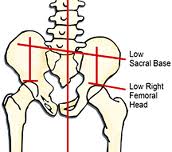Greater trochanteric pain syndrome GTPS is the term that has replaced Trochanteric Bursitis. It describes all pain on the outside of the upper thigh (near the greater trochanter). GTPS is a broad term and covers a range of possible problems including trochanteric bursitis, tears or tendonitis of the gluteus medius and minimus tendons and the Iliotibial band (ITB).
Symptoms of GTPS
This involves pain on outside of the hip and thigh. It may also spread a little down the outside of the leg and into the buttock muscles. Often lying on that hip is difficult at night.
What is GTPS
This can involve local tissues in area, or referred from elsewhere. Local tissues may be Gluteal muscle insertions, the Iliotibial band or Bursa. MRI scans have now found the bursa is not normally involved (less that 10%). Hence the move away from term Trochcanteric Bursitis.
It is now felt that if Trochcanteric Bursitis is present it usually secondary to the involvement of the Gluteal muscles.
Osteopathic / Physiotherapy treatment of GPTS
Treatment first involves first doing a full structural. examination. There are many factors that may conrtibute to the development of GPTS. These may be local or quite remote from where the symptoms are felt. Usually local treatment such a deep tissue massage into the gluteals and trigger point therapy in gluteals / gluteal tendons will be enough to be effective. However, sometimes some of the below factors may also need to be addressed. My experience is that a short leg or foot pronation rarely needs to be addressed (and the person may of had these for years before with no trouble). Most common (in my experience) is the ITB band, Sacro ilac joint and back - in that order.
GPTS from elsewhere
Pain on the outside of the hip and thigh is a very common referal area from other structures. These may include the low back, sacro iliac joint or hip joint itself.
- Low back Back pain for more info on back pain
- Sacroilac joints
- Hip joints The Hip joint for more info on hip joint
- Iliotibial band (ITB) ITB syndrome and runnersknee for more info ITB syndrome
- Short leg
- Pronated feet
- Low Back. Pain, discomfort and tenderness in the gluteal muscles (buttock muscles) and outside of thigh frequently has its origin from the back. Just because one gets tenderness on local palpation to the trochanteric area it does not mean that this is GTPS. Symptoms that come from the back can also refer tenderness. As well as referred symptoms, there may be structure problems with the back that result in stress on the area that may need addressing.
- Sacroiliac joints. Sacroiliac problems can result in trigger points in the gluteus medius / minimus as well as referring pain into the outer hip. Additionally, a twist in the pelvis can result in a pelvic side shift with resultant stress on gluteus medius tendon.
- Hip joints. Though problems in the hip joint itself (osteoarthritis) most commonly are felt in the groin occasionally it can be felt in the buttock or trochanteric area.
- Iliotibial band (ITB syndrome). Tightness in the ITB band or ITB syndrome is often associated with GTPS.
Deep tissue massage to the ITB can often be part of treatment. Note that the lower part of the ITB is often associated with runners knee. Sometimes people with GTPS will also have runners knee, and in this case it is likely that tightness in the ITB band is linking both.
- Short leg A short leg can be a factor in GTPS
Notice how the left side (looking at picture) is higher and thus putting the gluteus medius / tendon under more strain. The short leg may be anatomical (femur or tibia) or due to a twist in the pelvis.
- Pronated feet Pronated feet (flat feet) as well as being connected with ITB syndrome has also been associated with GTPS.
- Hip joints. Though problems in the hip joint itself (osteoarthritis) most commonly are felt in the groin occasionally it can be felt in the buttock or trochanteric area.
- Iliotibial band (ITB syndrome). Tightness in the ITB band or ITB syndrome is often associated with GTPS.
Deep tissue massage to the ITB can often be part of treatment. Note that the lower part of the ITB is often associated with runners knee. Sometimes people with GTPS will also have runners knee, and in this case it is likely that tightness in the ITB band is linking both.
- Short leg A short leg can be a factor in GTPS
Notice how the left side (looking at picture) is higher and thus putting the gluteus medius / tendon under more strain. The short leg may be anatomical (femur or tibia) or due to a twist in the pelvis.
- Pronated feet Pronated feet (flat feet) as well as being connected with ITB syndrome has also been associated with GTPS.



